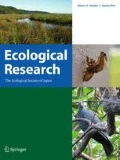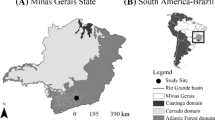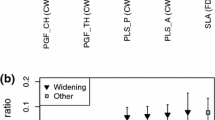Abstract
Knowledge of plant community structure and how it can confer resistance to climate change effects is required for the management of fluvial ecosystems. Findings from such studies can be applied in decision making processes to implement measures to maintain, conserve or improve fluvial quality. Floristic and environmental data from 100 sample stations located in three River Basin Districts in northern Portugal were gathered as part of the 2010 Water Framework Directive monitoring program carried out on mainland Portugal. Three habitat types were characterized based on the flow dynamic level: the wetted channel, the bankfull area and the riparian gallery. Hierarchical cluster analysis of environmental data revealed three distinct environmental groups of sites. Floristic data were organized by these environmental groups characterized by altitudinal, temperature and precipitation data variables. The combination of taxonomic diversity and species frequency reflect functional differences for these habitats, here explained by a resistance and resilience approach. More low-frequency species and higher levels of functional diversity occurred at stations with more variable environmental conditions. Predictive modelling of the future distribution of the three environmental groups under two different climate scenarios supported the relevance of low-frequency traits in conferring resistance to climatic change effects.







Similar content being viewed by others
References
Agras J, Chapman D (1999) A dynamic approach to the environmental kuznets curve hypothesis. Ecol Econ 28:267–277
Aguiar FC, Ferreira MT (2005) Human-disturbed landscapes: effects on composition and integrity of riparian woody vegetation in the Tagus River basin, Portugal. Environ Conserv 32:1–12
Aguiar FC, Ferreira MT (2006) Riparian and aquatic vegetation in Mediterranean-type streams (western Iberia). Limnetica 25:411–424
Aguiar FC, Ferreira MT, Moreira IS, Albuquerque A, Boatman ND, Clay DV, Pywell RF (2000) Riparian types on a Mediterranean basin. Asp Appl Biol 58:221–232
Aguiar FC, Ferreira MT, Albuquerque A, Moreira I (2007) Alien and endemic flora at reference and non-reference sites in Mediterranean-type streams in Portugal. Aquat Conserv Marine Freshwater Ecosyst 17:335–347
Aguiar FC, Ferreira MT, Albuquerque A, Rodríguez-González P, Segurado P (2009) Structural and functional responses of riparian vegetation to human disturbance: performance and spatial scale-dependence. Fundam Appl Limnol 175:249–267
Allen CR, Gunderson L, Johnson AR (2005) The use of discontinuities and functional groups to assess relative resilience in complex systems. Ecosystems 8:958–966
Allison G (2004) The influence of species diversity and stress intensity on community resistance and resilience. Ecol Monogr 74:117–134
Allison SD, Martiny JB (2008) Resistance, resilience, and redundancy in microbial communities. Proc Natl Acad Sci 105(Supplement 1):11512–11519
Andrés FN, Zapatero MG, Martín FG, Roselló JAE, Anta MÁS, Blanco LL (1986) Alisedas salmantinas y zamoranas. Studia botanica 5:39–52 [in Spanish]
Baldwin RA (2009) Use of maximum entropy modeling in wildlife research. Entropy 11:854–866
Benda L, Poff NL, Miller D, Dunne T, Reeves G, Pess G, Pollock M (2004) The network dynamics hypothesis: how channel networks structure riverine habitats. Bioscience 54:413–427
Benda L, Miller D, Andras K, Bigelow P, Reeves G, Michael D (2007) NetMap: a new tool in support of watershed science and resource management. Forest Science 53:206–219
Bernez I, Ferreira T (2007) River macrophytes in regulated Mediterranean-type rivers of southern Portugal. Belg J Bot 140:136–139
Bombino G, Gurnell AM, Tamburino V, Zema DA, Zimbone SM (2008) Sediment size variation in torrents with check dams: effects on riparian vegetation. Ecol Eng 32:166–177
Braun-Blanquet J (1979) Fitosociología. Bases para el estudio de las comunidades vegetales. Blume Madrid (in Spanish)
Bruno JF, Stachowicz JJ, Bertness MD (2003) Inclusion of facilitation into ecological theory. Trends Ecol Evol 18:119–125
Buiatti M, Longo G (2013) Randomness and multilevel interactions in biology. Theory Biosci 132:139–158
Carpenter SR, Fisher SG, Grimm NB, Kitchell JF (1992) Global change and freshwater ecosystems. Annu Rev Ecol Syst 23:119–139
Cha SH (2008) Taxonomy of nominal type histogram distance measures. City 1:325–330
Chapin FS III, Zavaleta ES, Eviner VT, Naylor RL, Vitousek PM, Reynolds HL, Hooper DU, Lavorel S, Sala OE, EHSE Sarah, Mack MC, Díaz S (2000) Consequences of changing biodiversity. Nature 405:234–242
Cinner JE, McClanahan TR, Daw TM, Graham NA, Maina J, Wilson SK, Hughes TP (2009) Linking social and ecological systems to sustain coral reef fisheries. Curr Biol 19:206–212
Coelho C, Silva R, Veloso-Gomes F, Taveira-Pinto F (2009) Potential effects of climate change on northwest Portuguese coastal zones. ICES J Marine Sci J Du Conseil 66:1497–1507
Commission European (2000) Directive 2000/60/EC of the European Parliament: establishing a framework for Community action in the field of water policy. Off J Eur Commun L327:1–72
Commission European (2009) Common implementation strategy for the water framework directive (2000/60/EC). River Basin Manag Chang Climate 24:141
Corenblit D, Tabacchi E, Steiger J, Gurnell AM (2007) Reciprocal interactions and adjustments between fluvial landforms and vegetation dynamics in river corridors: a review of complementary approaches. Earth Sci Rev 84:56–86
Cortes R, Hughes SJ, Pereira VR, Varandas S (2013) Tools for bioindicator assessment in rivers: the importance of spatial scale, land use patterns and biotic integration. Ecol Ind 34:460–477
Costa JC, Aguiar C, Capelo JH, Lousã M, Neto C (1998) Biogeografia de Portugal continental. Quercetea 0:5–56 [in Portuguese]
Crespí AL, Pereira A, Fernandes CP, Cortes R, Oliveira S, Ribeiro JA (2001) Descripción de la estrutura vegetal de comunidades riparias del Noroeste de Portugal. Boletín de la Real Sociedad Española de Historia Natural Sec Biol. 96:69–80 (in Spanish)
Crespí AL, Bernardos S, Castro A, Fernandes CP, Amich F (2005) Phytostructural characterization of several vegetation types in northern Portugal. II. The structural expressivity and the resistance of the vegetation. Plant Biosyst 139:387–398
Crespí AL, Ferreira M, Fonseca TF, Pacheco Marques C (2013) Structural and floristic behaviors in East Timor forest vegetation. Ecol Res 28:1081–1090
Direção Geral do Território (2006) Carta Corine Land Cover. http://www.dgterritorio.pt/cartografia_e_geodesia/mapas_on_line/. Accessed 29 Jul 2015
Dixon M (2003) Effects of flow pattern on riparian seedling recruitment on sandbars in the Wisconsin River, Wisconsin, USA. Wetlands 22:125–139
Downing AL, Leibold MA (2010) Species richness facilitates ecosystem resilience in aquatic food webs. Freshw Biol 55:2123–2137
Duarte P, Azevedo B, Ribeiro C, Pereira A, Falcão M, Serpa D, Bandeira R, Reia J (2007) Management oriented mathematical modelling of Ria Formosa (South Portugal). Transit Waters Monogr 1:13–51
European Commission (2015). Introduction to the new EU Water Framework Directive. http://ec.europa.eu/environment/water/water-framework/info/intro_en.htm. Accessed 29 Jul 2015
Farris JS (1969) On cophenetic correlation coefficients. Syst Zool 18:279–285
Feio MJ, Reynoldson TB, Ferreira V, Graça MAS (2007) A predictive model for freshwater bioassessment (Mondego river, Portugal). Hydrobiologia 589:55–68
Feio MJ, Aguiar FC, Almeida SFP, Ferreira J, Ferreira MT, Elias C, Serra SRS, Buffagni A, Cambra J, Chauvin C, Delmas F, Dörflinger G, Erba S, Flor N, Ferréol M, Germ M, Mancini L, Manolaki P, Marcheggiani S, Minciardi MR, Munné A, Papastergiadou E, Prat N, Puccinelli C, Rosebery J, Sabater S, Ciadamidaro S, Tornés E, Tziorztis I, Urbanič G, Vieira C (2014) Least disturbed condition for European Mediterranean rivers. Sci Total Environ 476:745–756
Fernández D, Barquín J, Ívarez-Cabria MA, Peñas FJ (2012) Delineating riparian zones for entire river networks using geomorphological criteria. Hydrol Earth Syst Sci Discus 9:4045–4071
Fernández-González F, Loidi J, Moreno JC (2005) Impacts on plant biodiversity. In: Moreno JM (ed) Impacts on climatic change in Spain. OCCE, Ministerio de Medio Ambiente, Madrid, pp 183–248
Ferreira MT, Aguiar FC, Nogueira C (2005) Changes in riparian woods over space and time: influence of environment and land use. For Ecol Manage 212:145–159
Fielding AH, Bel JF (1997) A review of methods for the assessment of prediction errors in conservation presence/absence models. Environ Conserv 24:38–49
Fryxell JM, Wilmshurst JF, Sinclair AR, Haydon DT, Holt RD, Abrams PA (2005) Landscape scale, heterogeneity, and the viability of Serengeti grazers. Ecol Lett 8:328–335
Garel E, Pinto L, Santos A, Ferreira Ó (2009) Tidal and river discharge forcing upon water and sediment circulation at a rock-bound estuary (Guadiana estuary, Portugal). Estuar Coast Shelf Sci 84:269–281
Gitay H, Wilson JB, Lee WG (1996) Species redundancy: a redundant concept? J Ecol 84:121–124
Gunderson LH (2000) Ecological resilience in theory and application. Annu Rev Ecol Syst 31:425–439
Gurnell AM, Bertoldi W, Corenblit D (2012) Changing river channels: the roles of hydrological processes, plants and pioneer fluvial landforms in humid temperate, mixed load, gravel bed rivers. Earth Sci Rev 111:129–141
Heller NE, Zavaleta ES (2009) Biodiversity management in the face of climate change: a review of 22 years of recommendations. Biol Conserv 142:14–32
Hering D, Borja A, Carstensen J, Carvalho L, Elliott M, Feld CK, Heiskanen AS, Johnson RK, Moe J, Pont D, Solheim AL, van de Bund W (2010) The European Water Framework Directive at the age of 10: a critical review of the achievements with recommendations for the future. Sci Total Environ 408:4007–4019
Hijmans RJ, Cameron SE, Parra JL, Jones PG, Jarvis A (2005) Very high resolution interpolated climate surfaces for global land areas. Int J Climatol 25:1965–1978
Hoelzer A (2003) Vegetation ecological studies at the lower course of Sabor river (Trás-os-Montes, NE Portugal). MsD These, University of Bremen, Bremen
Holling CS (1973) Resilience and stability of ecological systems. Annual Rev Ecol Evolu Sys 4:1–23
Honrado J, Alves P, Aguiar C, Ortiz S, Barreto Caldas F (2003) De Vegetatio Lusitana Notae-I: 1. Juresian riparian birch woodlands: Carici reuterianae—Betuletum celtibericae as. Nova. Silva Lusitana 11:237–241 [in Portuguese]
Hughes S, Santos J, Ferreira MT, Caraça R, Mendes AM (2009) Ecological assessment of an intermittent Mediterranean river using community structure and function: evaluating the role of different organism groups. Freshw Biol 54:2383–2400
Hughes SJ, Cabecinha E, Santos J, Mendes Andrade CM, Lopes DM, Trindade HM, Cabral JA, Santos M, Lourenço M, Aranha JT, Fernandes L, Morais MM, Leite SM, Oliveira PC, Cortes R (2012) A predictive modelling tool for assessing climate, land use and hydrological change on reservoir physicochemical and biological properties. Area 44(4):432–442
Hupp CR, Osterkamp WR (1996) Riparian vegetation and fluvial geomorphic processes. Geomorphology 14:277–295
INAG (2008) Insituto Nacional da Água. Protocolo de amostragem e análise para os macrófitos. In Manual para a avaliacão biológica da qualidade da água em sistemas fluviais segundo a Directiva Quadro da Água. http://www.apambiente.pt/dqa/assets/protocolo-de-amostragem-e-an%C3%A1lise-para-os-macr%C3%B3fitos.pdf. Accessed 29 Jul 2015, (in Portuguese)
Ives AR, Carpenter SR (2007) Stability and diversity of ecosystems. Science 317:58–62
Jansson R, Zinko U, Merritt DM, Nilsson C (2005) Hydrochory increases riparian plant species richness: a comparison between a free-flowing and a regulated river. J Ecol 93:1094–1103
Jiang J, Gao D, DeAngelis DL (2012) Towards a theory of ecotone resilience: coastal vegetation on a salinity gradient. Theor Popul Biol 82:29–37
Khavhagali VP (2011) Climate change impacts on plants. Grassroots 11:9–13
Lake PS (2000) Disturbance, patchiness, and diversity in streams. J North Am Benthol Soc 19:573–592
Martins Á, Crespí AL, Castro A, Fernandes CP, Rocha J, Bernardos S, Aguiar C, Amich F (2007) Contribuición para la caracterización florístico-ambiental del norte de Portugal. Botan Complut 31:99–111 (in Spanish)
May RM (1974) Stability and complexity in model ecosystems, 2nd edn. Princeton University Press, New Jersey
McGrady-Steed J, Harris PM, Morin PJ (1997) Biodiversity regulates ecosystem predictability. Nature 390:162–165
Meyer JL, Sale MJ, Mulholland PJ, LeRoy Poff N (1999) Impacts of climate change on aquatic ecosystems functioning and health. J Am Water Resour Assoc 35:1373–1386
Ministério do Ambiente, Ordenamento do Território e Energia 2015 Programa Nacional de Barragens de Elevado Potencial Hidroelétrico (PNBEPH). http://www.apambiente.pt/?ref=16&subref=7&sub2ref=9&sub3ref=835. Accessed 29 Jul 2015, (in Portuguese)
Molina JA (1996) Sobre la vegetación de los humedales de la Península Ibérica (1. Phragmiti-Magnocaricetea). Lazaroa 16:27–88 (in Spanish)
Naeem S, Knops JM, Tilman D, Howe KM, Kennedy T, Gale S (2000) Plant diversity increases resistance to invasion in the absence of covarying extrinsic factors. Oikos 91:97–108
Naiman RJ, Décamps H (1997) The ecology of interfaces: riparian zones. Annual Rev Ecol Evol Sys 28:621–658
Niemi GJ, McDonald ME (2004) Application of ecological indicators. Annual Rev Ecol Evol Sys, pp 89–111
North CP, Davidson SK (2012) Unconfined alluvial flow processes: Recognition and interpretation of their deposits, and the significance for palaeogeographic reconstruction. Earth Sci Rev 111:199–223
Occhipinti-Ambrogi A, Galil BS (2004) A uniform terminology on bioinvasions: a chimera or an operative tool? Mar Pollut Bull 49:688–694
Parmesan C (2006) Ecological and evolutionary responses to recent climate change. Annu Rev Ecol Evol Sys, pp 637–669
Pearson TN, Li HW, Lamberti GA (1992) Influence of habitat complexity on resistance to flooding and resilience of stream fish assemblages. Trans Am Fish Soc 121:427–436
Pereira MCDMD (2009) A flora e vegetação da serra de Monfurado (Alto Alentejo-Portugal). Guineana 15:153–166 (in Portuguese)
Pereira EMP (2013) Análise Geobotânica dos Bosques e Galerias Ripícolas da Bacia Hidrográfica do Tejo em Portugal. PhD thesis, University of Lisbon, Instituto de Geografia e Ordenamento do Território. Lisbon
Peterson GD (2002) Estimating resilience across landscapes. Conservation Ecology 6: 17. http://www.consecol.org/vol6/iss1/art17/. Accessed 29 Jul 2015
Peterson G, Allen CR, Holling CS (1998) Ecological resilience, biodiversity, and scale. Ecosystems 1:6–18
Peterson AT, Papes M, Eaton M (2007) Transferability and model evaluation in ecological niche moedeling: a comparison of GARP and Maxent. Ecography 30:550–560
Phillips SJ (2010) Species’ distribution modeling for conservation educators and practitioners. Exercise. American Museum of Natural History. Lessons in Conservation. http://ncep.amnh.org/linc. Accessed 15 Nov 2013
Phillips SJ, Dudík M, Schapire RE (2004) A maximum entropy approach to species distribution modeling. In: Proceedings of the 21st International Conference on Machine Learning. ACM Press, New York
Phillips SJ, Anderson RP, Schapire RE (2006) Maximum entropy modeling of species geographic distributions. Ecol Model 190:231–259
Pickett STA, Kolasa J, Armesto JJ, Collins SL (1989) The ecological concept of disturbance and its expression at various hierarchical levels. Oikos 54:129–136
Pimm SL (1984) The complexity and stability of ecosystems. Nature 307:321–326
Poff NL (1997) Landscape filters and species traits: towards mechanistic understanding and prediction in stream ecology. J North Am Benthol Soc pp 391–409
Portuguese National Institute of Statistic (2012). Censos 2011. Resultados definitivos. http://www.ine.pt/scripts/flex_definitivos/Main.html. Accessed 29 Jul 2015 (in Portuguese)
Ramirez J, Jarvis A (2008) High resolution statistically downscaled future climate surfaces. Int Centre Trop Agricult, CIAT
Rivas-Martínez S, de la Fuente García V (1986) Alisedas mediterráneo-iberoatlánticas en la Península Ibérica. Studia Botanica 5:9–38 (in Spanish)
Rodewald AD, Bakermans MH (2006) What is the appropriate paradigm for riparian forest conservation? Biol Conserv 128:193–200
Rozeira A (1944) A flora da província de Trás-os-Montes e Alto Douro. Memórias da Sociedade Broteriana 3:110–118 (in Portuguese)
Rykiel EJ (1985) Towards a definition of ecological disturbance. Aust J Ecol 10:361–365
Sabo JL, Sponseller R, Dixon M, Gade K, Harms T, Heffernan J, Jani A, Katz G, Soykan C, Watts J, Welter J (2005) Riparian zones increase regional species richness by harboring different, not more, species. Ecology 86:56–62
Santos JA, Corte-Real J, Leite SM (2005) Weather regimes and their connection to the winter rainfall in Portugal. Int J Climatol 25:33–50
Seavy NE, Gardali T, Golet GH, Griggs FT, Howell CA, Kelsey R, Small SL, Viers JH, Weigand JF (2009) Why Climate Change Makes Riparian Restoration More Important than Ever: Recommendations for Practice and Research. Ecol Restorat 27:330–338
Stevens PF (2001 onwards). Angiosperm Phylogeny Website. http://www.mobot.org/mobot/research/apweb/. Accessed 29 Jul 2015
Suding KN, Lavorel S, Chapin FS, Cornelissen JH, Diaz S, Garnier E, Goldberg D, Hooper DU, Jackson ST, Navas ML (2008) Scaling environmental change through the community-level: a trait-based response-and-effect framework for plants. Glob Change Biol 14:1125–1140
Taylor DL, Herriott IC, Stone KE, McFarland JW, Booth MG, Leigh MB (2010) Structure and resilience of fungal communities in Alaskan boreal forest soils. Can J For Res 40:1288–1301
The Angiosperm Phylogeny Group (2009) An update of the Angiosperm Phylogeny Group classification for the orders and families of flowering plants: APG III. Bot J Linn Soc 161:105–121
Thuiller W, Lavorel S, Araújo MB, Sykes MT, Prentice IC (2005) Climate change threats to plant diversity in Europe. Proc Natl Acad Sci USA 102:8245–8250
Tilman D (1996) Biodiversity: population versus ecosystem stability. Ecology 77:350–363
Trigo RM, DaCamara CC (2000) Circulation weather types and their influence on the precipitation regime in Portugal. Int J Climatol 20:1559–1581
Trigo RM, Pozo-Vázquez D, Osborn TJ, Castro-Díez Y, Gámiz-Fortis S, Esteban-Parra MJ (2004) North Atlantic Oscillation influence on precipitation, river flow and water resources in the Iberian Peninsula. Int J Climatol 24:925–944
Van Ruijven J, Berendse F (2010) Diversity enhances community recovery, but not resistance, after drought. J Ecol 98:81–86
Walker B (1995) Conserving biological diversity through ecosystem resilience. Conserv Biol 9:747–752
White PS (1979) Pattern, process, and natural disturbance in vegetation. Bot Rev 45:229–299
Acknowledgments
This work was carried out as part of the “Assessment of Ecological Sustainability of Fluvial Habitats of Protected or Classified Areas in the Minho/Lima Hydrographical Region V01/2010” contract 2010–2011 between the Northern River Basin District Administrative Body and the University of Trás-os-Montes e Alto Douro. The authors would like to thank FCT-Foundation of Science and Technology Science for João Rocha´s doctoral grant SFRH/BD/43167/2008. Samantha Jane Hughes is SUSTAINSYS funded post-doctoral fellow—North-07-0124-FEDER-0000044, financed by the Regional Operational Program North (ON. 2—The New North), under the National Strategic Framework (NSRF), through the European Regional Development Fund and PIDDAC via the Foundation for Science and Technology. This work was also supported by European Union Funds (FEDER/COMPETE—Operational Competitiveness Programme) and by national funds (FCT—Portuguese Foundation for Science and Technology) under the project FCOMP-01-0124-FEDER-022692.
Author information
Authors and Affiliations
Corresponding author
Electronic supplementary material
Below is the link to the electronic supplementary material.
About this article
Cite this article
Rocha, J., Hughes, S.J., Almeida, P. et al. Contemporary and future distribution patterns of fluvial vegetation under different climate change scenarios and implications for integrated water resource management. Ecol Res 30, 989–1003 (2015). https://doi.org/10.1007/s11284-015-1300-4
Received:
Accepted:
Published:
Issue Date:
DOI: https://doi.org/10.1007/s11284-015-1300-4




